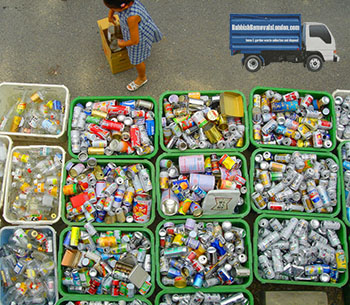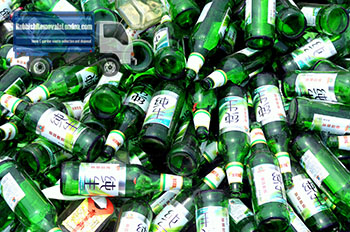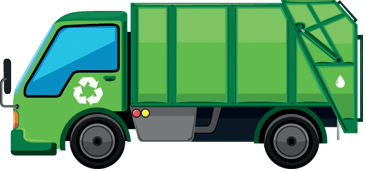Recycling of discarded domestic and commercial products and their packaging is one of the most important aspects of effective circular economy. Without recycling, new products and packaging would have to be made solely from virgin materials which in many cases is uneconomical and environmentally unfriendly. There are a series of steps leading from discarding a product to production of new items from recycled materials. Each step along the way is highly important and requires effective completion in order for the recycling process to work properly. Consumers as well as local waste management authorities are part of the so called recycling chain and everyone must do their bit in order for it to work properly.
Correct waste separation by domestic and commercial consumers
 Businesses and households are part of today’s consumer society. Whether it be domestic products, food stuffs or commercial supplies and raw materials, these entities consume on a daily basis and generate various types of waste. The most common types of waste generated by households and offices are:
Businesses and households are part of today’s consumer society. Whether it be domestic products, food stuffs or commercial supplies and raw materials, these entities consume on a daily basis and generate various types of waste. The most common types of waste generated by households and offices are:
- Organic waste (food scraps etc.);
- Solid waste (some of it recyclable);
- Hazardous waste (usually collected and recycled separately);
For a waste management and recycling system to work properly, waste also needs to be separated accordingly prior to removal and processing. In simple terms rubbish needs to be thrown out in the correct bin. In the UK, households and businesses make use of different colour rubbish bins and containers indicating which waste goes where. If bins and containers are not colour coded, they usually have clear labelling showing what type of waste they are meant to hold. Domestic and commercial consumers have the responsibility to separate their waste and use the correct bin. Provided this is done properly, it is up to local rubbish removal authorities to take over for the next step of the process which is regular waste removal and disposal.
Post-collection processing of domestic and commercial waste
Local rubbish removal and disposal bodies are responsible for the timely and effective collection of domestic and commercial waste, separated correctly (places in the correct bins/containers). Certain types of waste are collected more often than others, for instance organic and general waste are usually subject to weekly or fortnightly collection, whereas various forms of solid waste may be collected less frequently, say once a month. There are number of ways in which local authorities deal with the rubbish and junk they collect from homes and commercial establishments.
- Local authorities do their own separation and processing – in some cases, local authorities collect, separate (sort) rubbish and process it in their own treatment & recycling facilities. This however is the more uncommon situation as local governing bodies usually delegate separation and processing to private operators (privately run waste management companies).
- Local authorities only collect and deposit waste, but private operators are responsible for separation and processing/recycling of waste. This is the more common arrangement as it provides a stable joint enterprise between public and private sectors.
The actual separation process
Proper separation of waste is essential in order to produce higher quality recyclate. The purer the input the more efficient recycling and higher quality end product. Modern waste treatment plants use various types of advanced separation technology. Waste separation machinery these days is highly advanced and constantly evolving. Some countries in Europe are pioneers and established leaders in development and implementation of waste separation technology. Depending on the type of waste being separated different technologies can be used. Three of the most effective and widely used types of separation are:
- Chemical – waste is treated using special chemicals to separate useful materials/substances from unwanted impurities;
- Mechanical – usable waste is separated from general waste stream based on its physical characteristics i.e. weight, size, density, buoyancy etc.
- Optical – usually applied on glass waste, this technology uses a so called ‘computer eye’ to separate different types of glass waste based on their colour.
Extraction of recyclable material from waste
 Separation of waste is prior to extraction and recycling. Provided separation is successful and only the desired type of waste remains, the next step would be to extract and purify the recyclable material. Extraction and purification of recyclables is quite a specific process, requiring one or more advanced technologies, sometimes combination between chemical and mechanical treatment is needed. For the purpose of this article, recyclable waste is limited to paper, glass, metal and plastic. In a few words, this is how the system works:
Separation of waste is prior to extraction and recycling. Provided separation is successful and only the desired type of waste remains, the next step would be to extract and purify the recyclable material. Extraction and purification of recyclables is quite a specific process, requiring one or more advanced technologies, sometimes combination between chemical and mechanical treatment is needed. For the purpose of this article, recyclable waste is limited to paper, glass, metal and plastic. In a few words, this is how the system works:
- Paper waste – recycling paper waste is relatively easier than other types, and involves chemical and mechanical processing. Usually paper and cardboard waste is soaked in chemicals which break it down to a slush-like consistency known as pulp. Pulp is repeatedly treated with chemicals (including bleach) to clean and purify it, removing dyes, ink etc. Pulp is eventually dried and forms different types of recycled paper, reprocessed by manufacturers who use recycled paper materials.
- Plastic waste – usually plastic waste recycling begins with shredding or breaking down plastic into small bits and pieces. Once the homogenous mass of shredded plastic is ready, it is usually fed to special machines which melt it down using heat, chemicals or both. The most common type of recycled plastic is pellets. Pellets made of recycled plastic are used in the manufacturing of other plastic products. Some plastics are non-recyclable.
- Glass waste – glass waste is energy intensive to recycle, so the process is more complex. Glass waste is first separated, then mechanically broken down to small pieces. The most effective way to recycle glass is to melt it down in in kilns/ovens until liquefied. The recycled glass is then cut and shaped and cooled off for further processing (usually by specialised glass product manufacturers).
- Metal waste – metal waste is separated at specialised treatment plants in accordance to type of metal being extracted, this is done both chemically and mechanically. Different metals react to different chemicals, or melt at a specific temperature. Metal recycling is quite energy intensive and requires large scale installations. In most cases, separating different metals from metal waste stream is done at the treatment site.
Composition of collected and processed waste (domestic & commercial), UK 2014/15
| Type | Amount |
| Paper and Cardboard | 41.1% |
| Glass | 19.2% |
| Other Materials | 17.8% |
| WEEE | 8.4% |
| Textiles | 2% |
| Plastics | 7.4% |
| Metals | 4.1% |

